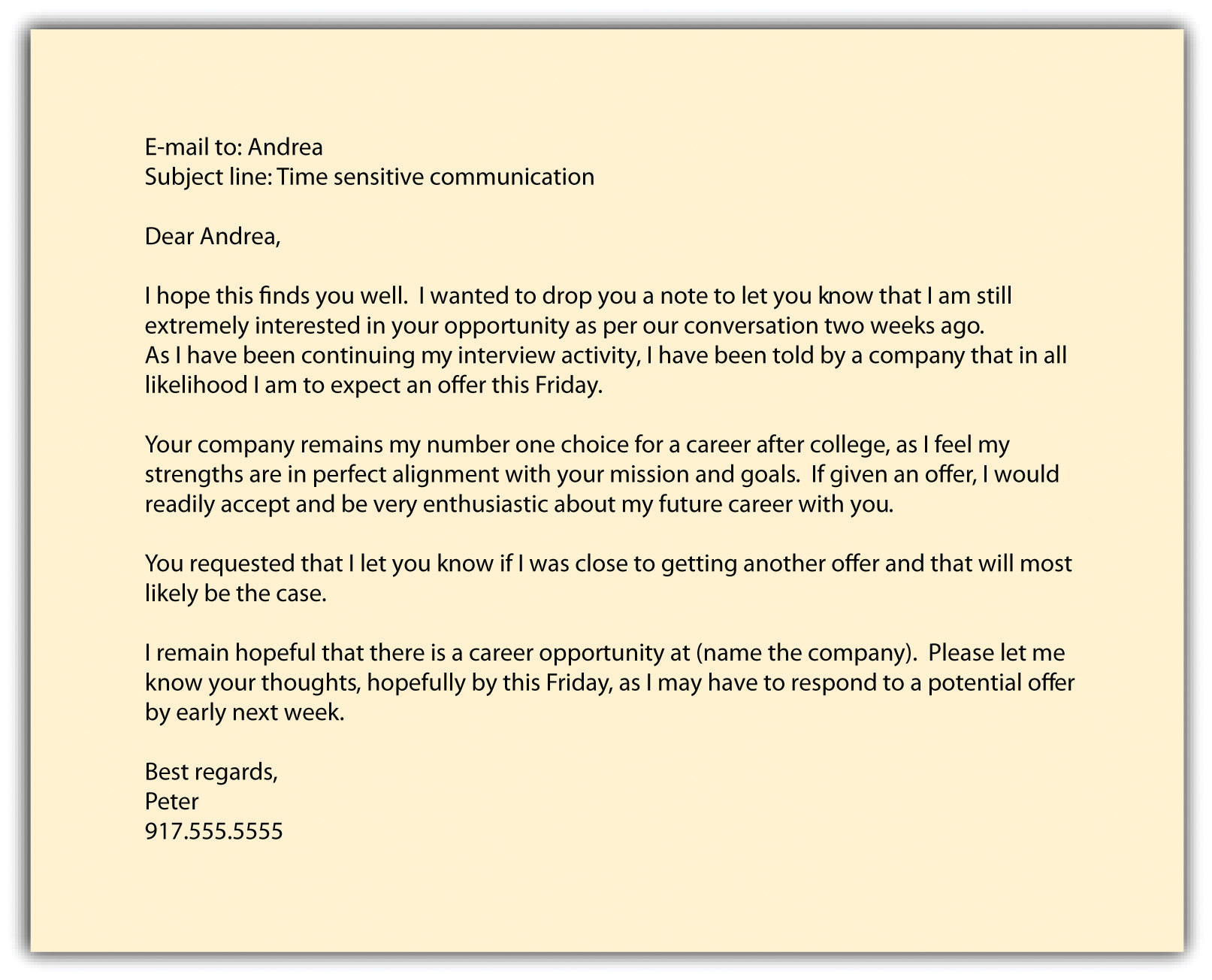This is “How to Get to a Decision and How to Juggle and Time Multiple Searches”, section 10.5 from the book Job Searching in Six Steps (v. 1.0). For details on it (including licensing), click here.
For more information on the source of this book, or why it is available for free, please see the project's home page. You can browse or download additional books there. To download a .zip file containing this book to use offline, simply click here.
10.5 How to Get to a Decision and How to Juggle and Time Multiple Searches
Learning Objectives
- Learn how to be a successful job search candidate by conducting multiple searches simultaneously. This has to happen given that you begin with ten legitimate targets.
- Use your strong and clear communication skills to keep recruiters informed of deadlines of any kind that can impede the offer process.
- Stay organized in order to juggle all aspects of your job search.

Step 1 of the job search emphasized that an individual should shoot for at least ten targets during a job search. Your goal is to receive as many offers as possible. Offers equal negotiation power. If you plan your job search strategy properly, many of your targets will move toward step 6.
As you move toward an offer with one company, it’s important to communicate with the others as to when you expect to receive an offer. To be fair, give each company the needed lead time to prepare an offer.
Case in Point
Peter interviews with Company A, which is his number one company. If he receives an offer, he will readily accept. Company A has interviewed Peter twice, and he is a finalist. They are not ready to extend offers until next month, but they ask that Peter let them know if he receives an offer from another company.
Peter has interviewed with Company B and he is put on hold.
Peter then interviews with Company C just hoping to get an offer, so he can leverage that with Company A. Things go very well and he is more interested than he thought. If given an offer, he would seriously consider accepting. Company C lets Peter know he will receive a call regarding his candidacy on Friday and that they feel very positive about what he has to offer. They do not, however, tell him that he will definitely receive an offer.
Peter has interviews with Company D, E, and F in the next ten days.
Peter calls Company A and sends the following e-mail:

This e-mail communicates six very important things:
- It addresses the urgency of the situation. The subject line highlights and notifies the company representative that the information is time sensitive, and in the last paragraph Peter states that he hopes to hear from them by Friday, or at the latest, by early next week.
- Peter reiterates his interest in the position—in the first paragraph, in the third paragraph, and again in the final paragraph. It’s helpful to let this company know that they are his number one choice.
- Peter lets the company representative know his interview activity is continuing, which also is helpful because the best candidates have a lot of interview activity. Recruiters know this, as do hiring managers.
- Peter follows the recruiter’s instruction and lets Company A know he may have another offer.
- Peter is, at all times, professional and respectful.
- Peter also has posture at this point. He is likely to receive an offer from Company C, and is giving Company A enough time to get their offer ready.
Another Case in Point
Donna wants to teach in an elementary school and has been networking and meeting several principals. Two of them have interviewed her and have expressed interest in her teaching at their school.
Donna really wants to work at P.S. 55 and has received an offer as a teaching assistant. Luckily, Donna was also offered a position at P.S. 22 for a full-time teaching position, but she would much rather work at P.S. 55. She can negotiate with the principal at P.S. 55 in the following way:
- Thank the principal at P.S. 55 for the offer. Even though it’s a teaching assistant versus teaching position, she should let her know she is flattered to receive the offer.
- Let the principal know that while she’s been looking for the past three to four months, another principal has offered her a full-time teaching position. She also appreciates receiving that offer; however, her number one choice is P.S. 55 because she spent time student teaching at the school, and because she has formed solid relationships with several of the teachers in addition to the principal.
- Is there any way she could have a full-time teaching position?
- If that isn’t possible, and she accepts the teaching assistant position, would it possibly turn into a teaching position, and, if so, how long would that take?
- If the principal cannot guarantee the better position, Donna should take the job at P.S. 22. Although the school is somewhat unfamiliar to her, she should trust that she can succeed there and advance in a stellar way.
Stay Organized
When you have multiple searches occurring at the same time, stay organized by having a playbookA short concise reference document that helps to direct an effort. of sorts, as illustrated in Table 10.1 "Job Search Plan".
Table 10.1 Job Search Plan
| Company Name | Name of Contact | E-mail and Phone | Position of Interest | How You Found Out about the Position | Actions Taken | Deadlines | Next Steps | |
|---|---|---|---|---|---|---|---|---|
| 1 | ||||||||
| 2 | ||||||||
| 3 | ||||||||
| 4 | ||||||||
| 5 | ||||||||
| 6 | ||||||||
| 7 | ||||||||
| 8 | ||||||||
| 9 | ||||||||
| 10 |
This single page in your playbook will keep all high-level information and each subsequent page can keep more detailed information. Reviewing this playbook on a regular basis ensures that you stay proactive on every job search target. It also reminds you that you should have ten targets at any given time, because some job targets are bound to go cold.
Use Strong Communication
The best candidates communicate consistently with recruiters, hiring managers, and networking contacts. If you’ve met three or four helpful networking contacts, and for some reason you did not make it to the final round, communicate with them as well, thanking them for the information they shared with you, even though your candidacy will not continue. Ask them if it’s OK that you continue to keep in touch, and wish them well with their careers. Individuals do shift positions and companies, and the world can be an amazingly small place. It’s quite possible that you will meet that person at another time, company, school, or organization, so include them in your LinkedIn contacts.
Poor communication can lead to poor decisions. If Donna didn’t explore full-time teaching opportunities at P.S. 55, she could have missed a full-time teaching position that opened up the next month. If Peter never sent the e-mail to Company A, and Company C gave Peter an offer with three days to accept, Company A may not have had the time to put together an offer by the deadline date set by Company C. Peter would have either gone with Company C (his second choice), or reneged on his acceptance to Company C by accepting the offer that finally came from Company A. Reneging is viewed negatively by some recruiters and by career services, so proceed with caution. At times, an employer will contact a student’s career services office to let them know that their offer was reneged on. Some career services offices deal harshly with students who breach such promises, so proceed with caution. Records of how many students renegeMeans that you first accept a job and then decide to later turn it down for another opportunity. on their offers aren’t kept, but one thing is certain: it’s never looked upon lightly. Communication with career services can help to avoid this at all costs.
One last point: never misrepresent an offer from a company to a representative at another company. The truth does have a way of making itself known.
Key Takeaways
- Whenever you have deadlines for offers, you must notify recruiters and hiring managers of these deadlines, giving them ample time to extend an offer themselves, or to let you know that they will not be able to do so. Either way, you achieve more clarity with more communication.
- Reneging is to be avoided at all costs. Through clear communication with the hiring manager, and with career services, this should and can be avoided.
- Never misrepresent anything about an offer from another company. It’s a small world after all, and recruiters often network with each other.
Exercises
- Create a playbook for your job search, listing ten targets in which you are most interested.
- If you do not have a contact at a particular company of interest, network until you get a contact.




